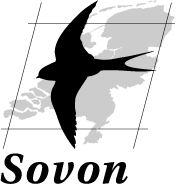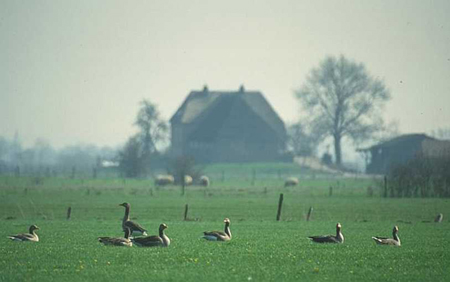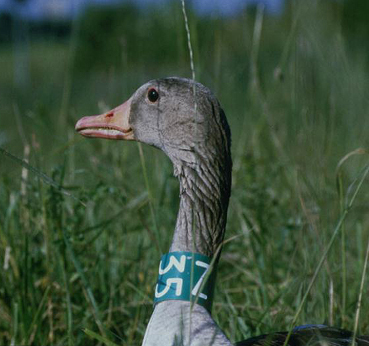12 years neckcollars
of Greylag Geese
in the Netherlands
Introduction

| Introduction | Flevoland | De Deelen | Ooijpolder | Scheelhoek | Waterland |
| Nederlands |
12 years neckcollars
|  |
Maarten J.J.E. Loonen, Chris van Turnhout, Berend Voslamber & Frank Willems
 I
I
Greylag Geese on a field in the Ooijpolder (Foto: Peter Eekelder)
In the period 1990-2001, in total 527 Greylag Geese have been given neck collars in the Netherlands
at 5 different ringing sites (Table 1). All geese belonged to the Dutch breeding popuation.
In the sixties, Greylag Geese in the Netherlands were a rare and welcome breeding bird.
Locally, this species was even re-introduced in an effort to re-establish breeding.
Since the seventies, the number of breeding birds has increased rapidly and in recent years the Greylag Goose showed the fastest recorded increase in breeding pairs (data SOVON, bmp-index).
Farmers were confronted with increasing goosse numbers on their land. They kept the nature organisations and owners of the nature reserves responsible for the damage on their crops.
At present, population control measures are undertaken in most areas. Clutches are destroyed and birds are shot during the breeding season with special permits.
The management is regionally organized, though little is known about the national implications.
Therefore, we started a ringing program, individually marking Greylag geese of the Dutch breeding population with neck collars.
For each inidvidual bird, we receive large numbers of ring readings from bird watchers who observe the codes through their telescope. Individuals are followed throughtout their annual migration.
Used codes start with J, P or Z, followed by two characters (either numbers of letters). The latter two characters are placed perpendicular
on the first charachter. The complete data set of 431 geese (1990-99) contained in spring
2000 almost 25.000 observations.

Ringing in the Ooijpolder. During a catch, normally five people are involved.
To speed up the process every person has a specialized task.
(Foto: Harvey van Diek)
The project started in 1990 with a goose catch in de Noorderplassen close to Almere.
The variation in the number of Greylag Geese in the nearby nature reserve could be explained by
the passage of various sub populations, each with their own timing (Voslamber
et al. 1993). Greylag geese from Norway were responsible for the spring and autumn maxima. During summer,
Greylag Geese from eastern Europe were the most numerous visitors. They came to the Oostvaardersplassen to moult.
In 1990, we wanted to know more about the distribution and migration of the local breeding birds in the Oostvaardersplassen and
caught our first 26 geese.
Three years later, the project expanded rapidly. In this year, nature management authorities in Zuid-Holland and Friesland
were confronted with claims for crop damage. Top what extent were the local breeding birds responsible for the crop damage opposed to the birds which just visited the area on migration?
By marking small numbers of the local breeding population, we were able to monitor their movements.
To our surprise there were large differences between the various ringing sites.
In the Scheelhoek birds formed a resident popualtion and stayed their entire annual cycle.
In contrast, the populations from the Flevopolder and the Deelen were migratory birds, moving to Spain in winter.
In 1996 we decided to expand to even more locations and ringing started in Waterland and the Ooijpolder.
In the Ooijpolder is the marking project also part of a larger study in the population biology of the geese.
Members of the Birding Group Nijmegen monitor clutch size, hatching success and survival of young to establish the factors responsible
for the local population size of Greylag Geese.

Adult Greylag Geese with neck collar green Z35 (Foto: Harvey van Diek)
We hope to continue with this research and have reorganised the feedback on resightings.
SOVON will be collecting all observations and will give feedback to observers. Please send all observations to:
|
SOVON Rijksstraatweg 178 6573 DG Beek-Ubbergen E-mail: greylag@sovon.nl |
| Tabel 1.
Numbers per location of neck collared Greylag Geese in the Netherlands over the period 1990-2001. |
|||||||||||||
|
90
|
91
|
92
|
93
|
94
|
95
|
96
|
97
|
98
|
99
|
00
|
01
|
Total
|
|
|
26
|
-
|
-
|
9
|
6
|
-
|
-
|
-
|
-
|
-
|
-
|
-
|
41
|
|
| De Deelen, Friesland |
-
|
-
|
-
|
16
|
32
|
25
|
-
|
-
|
-
|
-
|
-
|
-
|
73
|
| De Scheelhoek, Z-Holland |
-
|
-
|
-
|
95
|
31
|
-
|
-
|
-
|
-
|
-
|
-
|
-
|
126
|
|
-
|
-
|
-
|
-
|
-
|
-
|
45
|
25
|
18
|
-
|
-
|
-
|
88
|
|
| Ooijpolder, Gelderland |
-
|
-
|
-
|
-
|
-
|
-
|
-
|
44
|
32
|
27
|
47
|
49
|
199
|
| Total |
26
|
-
|
-
|
120
|
69
|
25
|
45
|
69
|
50
|
27
|
47
|
49
|
527
|
Authors
University of Groningen, Animal Ecology, Centre for Ecological and Evolutionary Studies
Present address: Koeman en Bijkerk bv, Haren
Maarten Loonen
SOVON Vogelonderzoek Nederland
Chris van Turnhout
Berend Voslamber
Frank Willems
Links to relevant other sites
Neck-collared Greylag Geese in Zeeuws-Vlaanderen
| next part | |||||
| Introduction | Flevoland | De Deelen | Ooijpolder | Scheelhoek | Waterland |